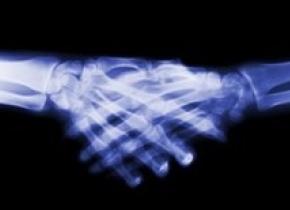
用数学揭开指关节叩响之谜
人们对于掰手指时关节咔嚓声的来源有很多争议,但新的数学模型也许能调和两种相反的观点。
撰文\播音:Christopher Intagliata
翻译:张艺箫
校对:郭晓
Knuckles cracking. You may not mind the sound. You may despise it. Or you could study it.
关节咔嚓声。你可能不会在意这种声响。你可能讨厌这种声响。或者,你可以研究这种声响。
Couple years back, Vinny Suja was taking a biomechanics class at the French Polytechnic School, outside Paris. And he was on the hunt for the perfect class project.
"Even though they suggested many projects, I couldn't find one which was both practical and that I could complete within the framework of this class. So in frustration, I was cracking my knuckles one day and that's when I realized—'Huh, that's interesting.'"
几年前,Vinny Suja在巴黎城外的法国理工大学学习生物力学课程。他在寻找完美的课题项目。
“虽然他们给了我很多建议,但我找不到一个既实用又能在本课程框架内完成的课题。有一天我在沮丧的时候掰了下手指,那时我突然意识到——‘嗯,这很有趣。’”
And so a project was born: the physics of knuckle cracking. It's actually a subject of intense scientific investigation. Back in 1971, scientists figured they knew how it worked: the cracking sound was caused by bubbles popping within the fluid surrounding the knuckles.
<<cracking sound>>
Or so they thought—because in 2015 shots were fired, in the form of MRI visualization of the knuckles post-cracking.
<<cracking sound>>
In fact, the bubbles were still there. The whole process happens too fast for imaging technology to visualize in real time—you’d need to shoot at 1,200 frames per second, 10 times faster than the best x-ray and MRI machines on the market. "And that's when we realized that a model could help people better understand the origin of this sound."
这样一来,课题就诞生了:掰手指时关节响声的物理学原理。这其实是一个非常有趣的科学课题。早在1971年,科学家们就得出了掰手指响声的机制:响声是由关节周围组织液中的气泡破裂引起的。
<<关节咔嚓声>>
或者说那些科学家们以为自己得出了结论——因为2015年,人们拍摄了叩响后指关节的MRI可视化照片,证明这种假设是错的。
<<关节咔嚓声>>
事实上,组织液中的气泡并没有破裂。整个过程发生得太快,影像技术无法实时显示。你需要以每秒1200帧的速度拍摄,这比市场上最好的X光机和MRI机器快10倍。
“这时我们意识到建立一个数学模型可以帮助人们更好地理解这种声音的起源。”
So, using mathematical models, Suja and his colleague Abdul Barakat found that just a partial collapse of the bubbles could cause cracking sounds of the same degree, which might explain why the 2015 researchers still saw bubbles after the crack. The details are in the journal Scientific Reports [V. Chandran Suja & A. I. Barakat, A Mathematical Model for the Sounds Produced by Knuckle Cracking].
所以,利用数学模型,Suja和他的同事Abdul Barakat发现气泡只需部分压缩就可能产生同样大小的声音,这也许可以解释为什么2015年的研究人员在关节叩响之后仍然能看到气泡。论文的更多内容发表在《科学报告》(Scientific Reports)杂志上。
Further modeling of bubble behavior, both pre- and post-pop, will be needed, they say, before they’re confident that they've truly cracked the case.
他们认为,在确定他们真正揭开关节扣响之谜之前,还需要对破裂前和破裂后的气泡状态进行进一步的模拟。
未经书面许可任何人不得复制或镜像
京ICP备11000850号
 京公网安备11010502039775号
京公网安备11010502039775号 信息网络传播视听节目许可证0111611号
国家科技基础条件平台

















